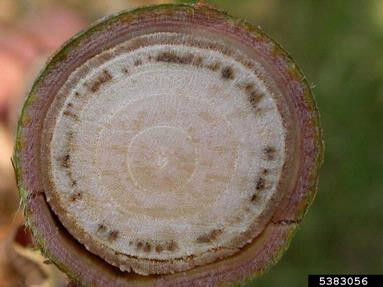Dutch Elm Disease
Dutch elm disease is a vascular wilt of elms caused by a fungus that is transmitted by bark beetles and root grafts. The fungus originated in Asia; the name “Dutch” refers to the identification of this disease and causal agent in the Netherlands by a Dutch scientist. The story of Dutch elm disease is long and interesting: it spans more than a century and involves complicated international politics, multiple continents, symbiotic relationships between several insects and pathogens, inter-species hybridization of fungi, and in the end, the catastrophic loss of an American icon. The disease has killed millions of elms in both Europe and the U.S. since the early 1900’s.
Two waves of the disease, first in the 1930’s and then again in the 1970’s, all but eliminated the American elm from the streets of U.S. cities. Elms are beginning to make a comeback however, due to integrated management programs, systemic fungicides, and disease resistant cultivars.

Early symptoms are often confused with drought. Usually one branch or an isolated area of the crown will “flag”: leaves will wilt and turn yellow; then reddish-brown and die. As the pathogen spreads out of the infected branch, larger areas of the crown begin to rapidly wilt resulting in crown dieback. Complete wilting can occur within a few months of infection, but it may take a year or more. Removal of bark on symptomatic branches or the main stem will reveal dark brownish-purple streaking in the outer sapwood. Pathogen spread through root grafts may result in wilt development in nearby trees in subsequent years; trees infected through root grafts usually wilt more quickly than bark beetle-related infections.
The fungus produces microscopic fruiting bodies that are not visible in the field. Diagnosis based on vascular streaking/discoloration is usually reliable, but the diagnosis can be confirmed in a laboratory.
Transmission by insect vectors is managed by rapid removal of diseased trees to eliminate breeding habitat for elm bark beetles. Firewood from diseased trees should be tightly covered in plastic for at least one year or burned immediately. Do not transport elm firewood. Root graft transmission is managed by severing root grafts between trees with a vibratory plow or trencher.
Systemic fungicides are available that can protect high- value trees for one to three years; if the disease is caught early enough and has not spread into the root system, these fungicides can be used to successfully eradicate the fungus and save a diseased tree. Likewise, experienced arborists or tree surgeons can prune out diseased branches, or even infected sections of the stem, to save a tree in the early stages of disease. Disease resistant cultivars of American elm are now available.
